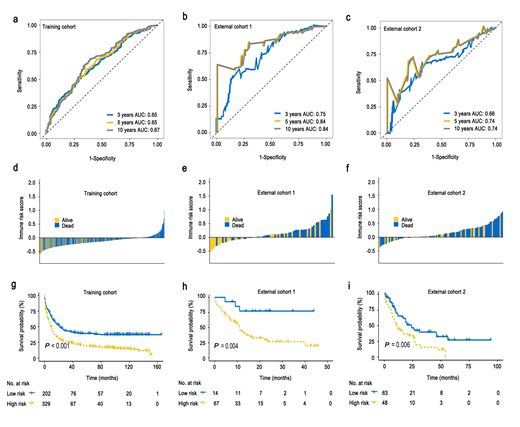Background: The present prognosis for AML mainly rely on the cyto- and molecular genetic features. However, the bone marrow microenvironment also plays a critical role in the development and progression of the disease, and the immune signature within the bone marrow microenvironment of AML remains unknown, and should be clarified.
Patients and methods: Here, we applied the robust algorithm CIBERSORT method to generate the distribution and frequency of 22 immune subsets in the bone marrow of AML from public datasets. The associations between the overall survival and proportions of putative marrow immune cell types were analyzed to generate an immune risk score in a public training cohort according to LASSO cox regression model and validated in other validation cohorts. Gene Set Enrichment Analysis was adopted to analyze the immune risk score associated biological phenotypes.
Results: Data from GSE37642 (n = 531) were used for immune model estimation, and samples from GSE425 (n =81) and TCGA (n =111) were served as external cohorts for validation. We first derived the 22 immune subsets through CIBERSORT, and found that monocytes, resting mast cells, eosinophils, CD8+T cells, resting NK cells, resting dendritic cells and resting memory CD4+ T cells were the most represented cell fractions within AML bone marrow microenvironment. LASSO cox regression was then applied to identify a total of 10 immune subsets to generate the immune risk score that may predict the survival prognosis of AML patients. This model has an excellent reproducibility, with the area under curve of the immune risk score at 5- year OS of 0.65, 0.84 and 0.74 in the training, external 1 and external 2 cohort. Patients with low immune risk score had a significant survival advantage than those with high immune risk score (5-year OS: 39.2 vs 19.6%, P < 0.001 for the training cohort; 77.4 vs 20.1%, P = 0.004 for the external cohort 1; 27.2 vs 0.0%, P = 0.006 for the external cohort 2). After adjusting the confounding variables of the classic ELN risk category and other clinical factors, the multivariable analysis revealed that immune risk score remained an independent prognostic factor for OS in all the three cohorts (HR: 1.34, 5.42 and 2.16 for the training, external cohort1 and 2 cohorts; all P < 0.05). Next, we explored the related biological phenotypes to immune risk score and found that the immune risk score was significantly associated with the markers of immune checkpoint (HMGB1, CEACAM1, LAG3 and CTLA-4), cell proliferation (NOTCH1, LYN, TSC2, SETBP1, TGFBR2, MAP3K14, TP53, NFKB2 and FOXO1), DNA repairment (RAD50 and BRCA1), epigenetic regulation and transcriptional regulation (SRSF6, DNMT3, TLE1). Furthermore, GSEA analysis indicated a significant enrichment of active immune-related pathways in low immune risk group. Finally, we noted that the immune risk score consistently increased follow the increased cytogenetic risk level.
Conclusions: The study identified a novel immune prognostic category of AML, which may be used as another prognostic tool that complements the existing genetic risk classification.
No relevant conflicts of interest to declare.
Author notes
Asterisk with author names denotes non-ASH members.


This feature is available to Subscribers Only
Sign In or Create an Account Close Modal